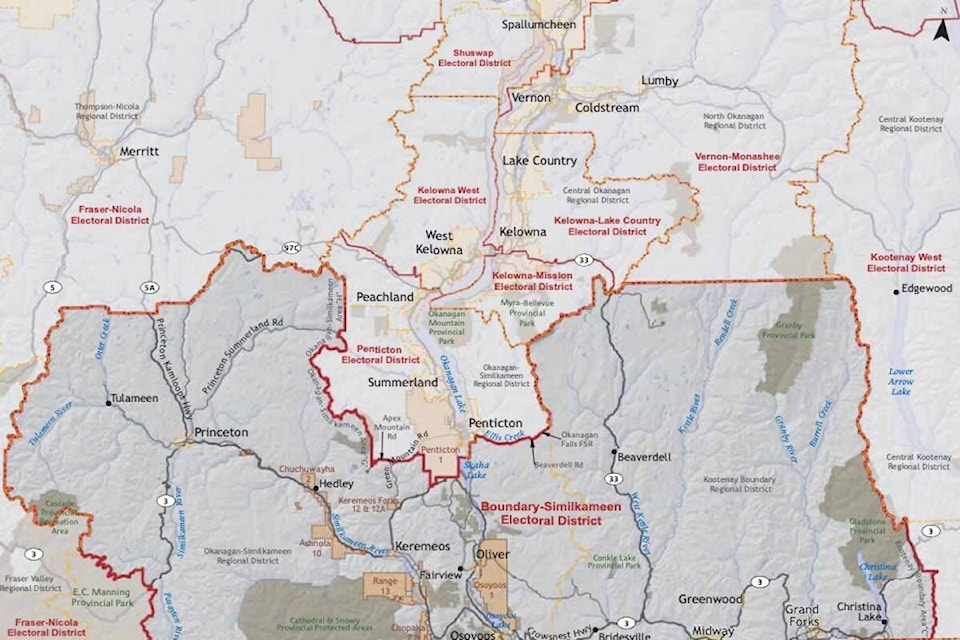The B.C. Electoral Boundaries Commission will be holding a public meeting in South Central and Southeastern B.C. next week for residents to speak their minds on the ongoing electoral boundaries review.
Between April 4 and 8, the Commission will visit the nine communities of Nelson, Trail, Radium Hot Springs, Cranbrook, Penticton, ¡¡ß…Ò…Á, Salmon Arm, Revelstoke, and Kamloops, ahead of changes to local riding boundaries. A review is held every two elections.
Under changes made in May 2021 as legislated by the NDP government, B.C. could have up to six new ridings added to the existing 87, while protections that prevent the reduction of rural ridings in favour of accumulating seats in major urban centres were removed.
The Kootenays is one region that had protections previously – with the number of ridings required before 2021 being four across both East and West Kootenay. Another eight ridings in Northern B.C. and five in Thompson-Caribou also lost their protections.
According to Kootenay East MLA, Tom Shypitka, the threat of losing rural representation was real as re-drawing borders based on population could see the number of seats in the Kootenays fall. While the population of rural B.C. is growing, urban areas are growing faster.
“With a large area comes a lot of different and unique political challenges, whether its access to healthcare or wildlife management issues or education - it seems the wider the area, the more unique issues pop up,” said Shypitka. His riding, Kootenay East, stretches from West of Moyie to include all of Cranbrook and the South Country, along with the entire Elk Valley.
Shypitka said that while border changes in the lower mainland accounting for differences in the population of a few thousand saw boundaries move a few city blocks, in the interior such a change based on population could see boundaries move hundreds of kilometres.
“Once you get out to these areas the size of small European countries, with lots of different First Nations, different businesses and industries – access to health care can be wildly different from one end to the other. When you expand those boundaries, those issues become more complex and complicated, so you get a breakdown of representation.”
Shypitka said that there was a “good chance” that all of the East Kootenays could be condensed into just one riding, rather than two as it exists now. The other riding is Columbia River-Revelstoke, which goes from Kimberley all the way to Revelstoke. Both are held by the BC Liberal Party.
In B.C., if the population is divided evenly between 87 ridings each riding should have a population of a little under 57.5k. Kootenay East is home to 44.4k, while Columbia River-Revelstoke is home to 37.6k.
“But this shouldn’t be about politics because ridings change all the time. It is really a long-term view on how rural issues become eroded when you make these ridings really big. I can’t even imagine travelling out to Revelstoke (from Cranbrook) to see a constituent and vice versa.”
Shypitka said that at the very least, he hoped that the number of ridings in rural B.C. would remain the same.
“Once these boundaries are set, it’s hard to make them smaller. If we expand them now, we’re stuck with them for quite a while, and I’d rather see it go the other way.”
More information on the Electoral Boundaries Commission the regional public meetings can be found on the bcebc.ca website. There will also be a virtual public meeting for these regions on Monday, April 11.
The Electoral Boundaries Commission will be concluding public consultation for a preliminary report on May 31. Submissions can be made online, at public meetings or in writing. The report is expected to be published in Fall 2022.
READ MORE:
scott.tibballs@thefreepress.ca
Like us on Facebook and follow us on Twitter




